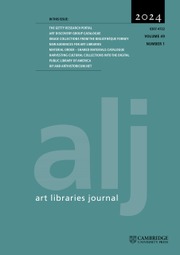Crossref Citations
This article has been cited by the following publications. This list is generated based on data provided by
Crossref.
Hamersveld, Ineke van
1987.
Information services in the fields of art and architecture.
Art Libraries Journal,
Vol. 12,
Issue. 1,
p.
8.
1988.
Report of the ICONCLASS Workshop, November 2–4, 1987.
Visual Resources,
Vol. 5,
Issue. 3,
p.
205.
Coulson, Anthony J.
1988.
Picture libraries: a survey of the present situation and a look into the future.
Art Libraries Journal,
Vol. 13,
Issue. 2,
p.
9.
Coulson, Anthony J.
1994.
‘To promote art librarianship’: twenty-five years of ARLIS publications.
Art Libraries Journal,
Vol. 19,
Issue. 3,
p.
44.
ENSER, P.G.B.
1995.
PROGRESS IN DOCUMENTATION PICTORIAL INFORMATION RETRIEVAL.
Journal of Documentation,
Vol. 51,
Issue. 2,
p.
126.
Baxter, Graeme
and
Anderson, Douglas
1995.
Image indexing and retrieval: some problems and proposed solutions.
New Library World,
Vol. 96,
Issue. 6,
p.
4.
1996.
Erratum.
Internet Research,
Vol. 6,
Issue. 4,
p.
67.
Jörgensen, Corinne
1998.
Attributes of images in describing tasks.
Information Processing & Management,
Vol. 34,
Issue. 2-3,
p.
161.
Olszewska, Anna
and
Gancarczyk, Joanna
2017.
Digital humanities using content-based image retrieval: The Visual Studies Toolkit.
p.
1.
Díaz-Corona, Dayany
Lacasta, Javier
and
Nogueras-Iso, Javier
2018.
Barriers for the access to knowledge models in Linked Data cultural heritage collections.
p.
1.
Prabhune, Ajinkya
Stotzka, Rainer
Sakharkar, Vaibhav
Hesser, Jürgen
and
Gertz, Michael
2018.
MetaStore: an adaptive metadata management framework for heterogeneous metadata models.
Distributed and Parallel Databases,
Vol. 36,
Issue. 1,
p.
153.
Strezoski, Gjorgji
and
Worring, Marcel
2018.
OmniArt.
ACM Transactions on Multimedia Computing, Communications, and Applications,
Vol. 14,
Issue. 4,
p.
1.
Díaz-Corona, Dayany
Lacasta, Javier
Latre, Miguel Ángel
Zarazaga-Soria, F. Javier
and
Nogueras-Iso, Javier
2019.
Profiling of knowledge organisation systems for the annotation of Linked Data cultural resources.
Information Systems,
Vol. 84,
Issue. ,
p.
17.
Milani, Federico
and
Fraternali, Piero
2021.
A Dataset and a Convolutional Model for Iconography Classification in Paintings.
Journal on Computing and Cultural Heritage,
Vol. 14,
Issue. 4,
p.
1.
Pinciroli Vago, Nicolò Oreste
Milani, Federico
Fraternali, Piero
and
da Silva Torres, Ricardo
2021.
Comparing CAM Algorithms for the Identification of Salient Image Features in Iconography Artwork Analysis.
Journal of Imaging,
Vol. 7,
Issue. 7,
p.
106.
Pflüger, Hermann
2021.
A language to analyze, describe, and explore collections of visual art.
Visual Computing for Industry, Biomedicine, and Art,
Vol. 4,
Issue. 1,
Cetinic, Eva
2021.
Towards Generating and Evaluating Iconographic Image Captions of Artworks.
Journal of Imaging,
Vol. 7,
Issue. 8,
p.
123.
Cetinic, Eva
2021.
Pattern Recognition. ICPR International Workshops and Challenges.
Vol. 12663,
Issue. ,
p.
502.
Santos, Iria
Castro, Luz
Rodriguez-Fernandez, Nereida
Torrente-Patiño, Álvaro
and
Carballal, Adrián
2021.
Artificial Neural Networks and Deep Learning in the Visual Arts: a review.
Neural Computing and Applications,
Vol. 33,
Issue. 1,
p.
121.
Bos, Johan
2022.
A semantically annotated corpus of tombstone inscriptions.
International Journal of Digital Humanities,
Vol. 3,
Issue. 1-3,
p.
1.

